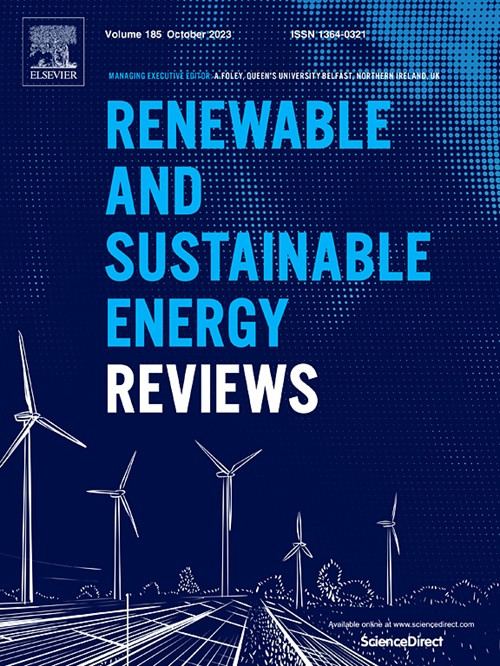中国海南垃圾发电在工业蒸汽供应和碳减排方面的潜力评估
IF 16.3
1区 工程技术
Q1 ENERGY & FUELS
引用次数: 0
摘要
随着全球人口的增长和城市化进程的加快,废物管理已成为全球面临的一项重大挑战。能源回收可在废物管理中发挥关键作用,从城市固体废物(MSW)中回收能源的潜力在废物管理规划中非常重要。本研究开发了一个评估框架,用于评估垃圾发电(WtE)技术在供应工业蒸汽和减少碳排放方面的潜力,支持在空间供热需求有限的地区提高 WtE 系统的能源效率。该框架整合了 MSW 预测、能源系统建模、空间供需匹配以及技术、经济和环境性能评估。中国海南是该框架的应用案例研究。通过统计数据、问卷调查和实地调查收集数据,以评估当地的 MSW 资源和工业蒸汽需求。建立了城市固体废物预测模型和 WtE 模型,以估算到 2030 年的蒸汽供应量,随后对供需匹配和碳减排潜力进行了评估。结果表明,如果存在适当的工业用热需求,WtE 工厂提供的蒸汽可以显著减少制造业中化石燃料的使用和相关排放。城市固体废物收集的空间协调可改善废物供应与蒸汽需求之间的匹配,优化现有激励结构可提高经济可行性和气候效益。在海南案例中,这种方法可使制造工厂的碳排放量减少高达 87.1%,整体碳排放量减少 21.6%。本研究旨在为未来的城市固体废物管理和工业能源供应决策提供信息,并为减少全球工业运营中的碳排放做出贡献。本文章由计算机程序翻译,如有差异,请以英文原文为准。
Assessment of the waste-to-energy potential for industrial steam supply and carbon emission reduction in Hainan, China
As global population grows and urbanization accelerates, waste management becomes a major challenge worldwide. Energy recovery can play a key role in waste management, and its potential from municipal solid waste (MSW) is important in waste management planning. This study develops an assessment framework to evaluate the potential of waste-to-energy (WtE) technology for supplying industrial steam and reducing carbon emissions, supporting improvements in the energy efficiency of WtE systems in regions with limited space heating demand. The framework integrates MSW forecasting, energy system modeling, spatial demand–supply matching, and evaluation of technical, economic, and environmental performance. Hainan, China, serves as a case study to demonstrate its application. Data were collected through statistics, questionnaires, and field surveys to evaluate local MSW resources and industrial steam demand. MSW prediction and WtE models were constructed to estimate steam supply by 2030, followed by an evaluation of supply–demand matching and carbon reduction potential. The results showed that steam supplied by WtE plants can significantly reduce fossil fuel use and associated emissions in manufacturing, provided appropriate industrial heat demand exists. Spatial coordination of MSW collection can improve the alignment between waste supply and steam demand, and optimizing existing incentive structures can enhance economic viability and climate benefits. In the Hainan case, this approach can reduce carbon emissions from manufacturing plants by up to 87.1 %, and overall carbon emissions by 21.6 %. This study aims to inform future MSW management and industrial energy supply decisions, and contribute to reducing carbon emissions in global industrial operations.
求助全文
通过发布文献求助,成功后即可免费获取论文全文。
去求助
来源期刊

Renewable and Sustainable Energy Reviews
工程技术-能源与燃料
CiteScore
31.20
自引率
5.70%
发文量
1055
审稿时长
62 days
期刊介绍:
The mission of Renewable and Sustainable Energy Reviews is to disseminate the most compelling and pertinent critical insights in renewable and sustainable energy, fostering collaboration among the research community, private sector, and policy and decision makers. The journal aims to exchange challenges, solutions, innovative concepts, and technologies, contributing to sustainable development, the transition to a low-carbon future, and the attainment of emissions targets outlined by the United Nations Framework Convention on Climate Change.
Renewable and Sustainable Energy Reviews publishes a diverse range of content, including review papers, original research, case studies, and analyses of new technologies, all featuring a substantial review component such as critique, comparison, or analysis. Introducing a distinctive paper type, Expert Insights, the journal presents commissioned mini-reviews authored by field leaders, addressing topics of significant interest. Case studies undergo consideration only if they showcase the work's applicability to other regions or contribute valuable insights to the broader field of renewable and sustainable energy. Notably, a bibliographic or literature review lacking critical analysis is deemed unsuitable for publication.
 求助内容:
求助内容: 应助结果提醒方式:
应助结果提醒方式:


